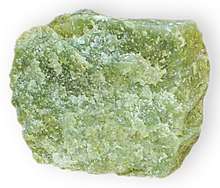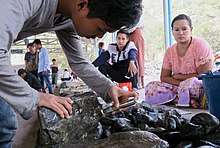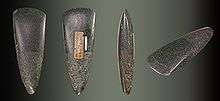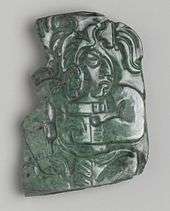Jadeite
Jadeite is a pyroxene mineral with composition NaAlSi2O6. It is monoclinic. It has a Mohs hardness of about 6.5 to 7.0 depending on the composition. The mineral is dense, with a specific gravity of about 3.4.
| Jadeite | |
|---|---|
 Jadeite from Burma | |
| General | |
| Category | Pyroxene group |
| Formula (repeating unit) | NaAlSi2O6 or Na(Al,Fe3+)Si2O6 |
| Strunz classification | 9.DA.25 |
| Crystal system | Monoclinic |
| Crystal class | Prismatic (2/m) (same H-M symbol) |
| Space group | C2/c |
| Identification | |
| Color | Apple-green, emerald-green, bluish green, leek-green, purplish blue, greenish white, white, black, may show green spots, rarely blue or violet; colorless in thin section. Often also banded. |
| Crystal habit | Commonly massive, or fibrous, granular; prismatic crystals rare |
| Twinning | Single and lamellar twinning on [100] and [001] |
| Cleavage | Good on [110] |
| Fracture | Splintery |
| Mohs scale hardness | 6.5 - 7 |
| Luster | Subvitreous, pearly on cleavages |
| Streak | White |
| Diaphaneity | Translucent |
| Specific gravity | 3.24 to 3.43 |
| Polish luster | vitreous to greasy[1] |
| Optical properties | Biaxial (+) |
| Refractive index | nα = 1.654 - 1.673 nβ = 1.659 - 1.679 nγ = 1.667 - 1.693 |
| Birefringence | δ = 0.013 - 0.020 |
| Dispersion | r > v; moderate to strong. |
| Ultraviolet fluorescence | Dark colors are generally inert. Light green – inert to weak white in long wave, generally inert in short wave; light yellow – inert to weak green in long wave, generally inert in short wave; white – inert to weak in long wave, generally inert in short wave; light purple – inert to weak white or weak brownish red in long wave, generally inert in short wave; some dyed lavender colors – moderate to strong orange in long wave, weaker in short wave[1] |
| References | [2][3][4] |
Name
The name jadeite is derived (via French: jade and Latin: ilia[5]) from the Spanish phrase "piedra de ijada" which means "stone of the side". The Latin version of the name, lapis nephriticus, is the origin of the term nephrite, which is also a variety of jade.
Chemistry
Jadeite forms solid solutions with other pyroxene endmembers such as augite and diopside (CaMg-rich endmembers), aegirine (NaFe endmember), and kosmochlor (NaCr endmember). Pyroxenes rich in both the jadeite and augite endmembers are known as omphacite. Jadeite is formed in metamorphic rocks under high pressure and relatively low temperature conditions. Albite (NaAlSi3O8) is a common mineral of the Earth's crust, and it has a specific gravity of about 2.6, much less than that of jadeite. With increasing pressure, albite breaks down to form the high-pressure assemblage of jadeite plus quartz. Minerals associated with jadeite include: glaucophane, lawsonite, muscovite, aragonite, serpentine and quartz.
Rocks that consist almost entirely of jadeite are called jadeitite. In all well-documented occurrences, jadeitite appears to have formed from subduction zone fluids in association with serpentinite.[6] Jadeitite is resistant to weathering, and boulders of jadeitite released from the serpentine-rich environments in which they formed are found in a variety of environments.
Colors
_Bursa_Province%2C_northwestern_Turkey.jpg)

Jadeite's color commonly ranges from white through pale apple green to deep jade green but can also be blue-green (like the recently rediscovered "Olmec Blue" jade), pink, lavender and a multitude of other rare colors. Chloromelanite is a very dark green to black variety.[7] Color is largely affected by the presence of trace elements such as chromium and iron. Its translucence varies from opaque to almost clear. Variations in color and translucence are often found even within a single specimen. Jadeite is reported from California, US; Myanmar; New Zealand; Guatemala; Itoigawa, Japan;[8] other localities of jadeite include Kazakhstan; Russia; British Columbia, Canada; Italy and Turkestan.
Stone Age use

Over 180 axe heads made from jadeitite quarried in northern Italy in the Neolithic era have been found across the British Isles.[9][10] Because of the difficulty of working this material, all the axe heads of this type found are thought to have been non-utilitarian and to have represented some form of currency or be the products of gift exchange.[11]
A great many jadeite beads and axe heads as well as the remains of jadeite workshops from the Neolithic era have been uncovered in Itoigawa, Japan. These beads and axes were traded throughout Japan and the Korean Peninsula and were produced by the world's oldest known jadeite-using culture, centered on the Itoigawa region.[12][13]

Jade
Jadeite is one of two minerals recognized as the gemstone jade. The other is nephrite. Jadeite from the Motagua Valley, Guatemala, was used by the Olmec and Maya peoples, as well as the indigenous peoples of Costa Rica. In the West, the most highly valued colors of jadeite are the intensely green, translucent varieties, though traditionally white has been considered the most valuable of the jades by the Chinese.
Other colors, like "Olmec blue" jade, which is characterized by its deep blue-green, translucent hue with white flecking, are also becoming more highly valued because of its unique beauty and historical use by the Mesoamerican Olmec and also in Costa Rica;[14] however, this variety was only recently rediscovered and is only being minimally exploited by native Guatemalans. It is thus difficult to obtain and as yet too rare and little known to have attained great value as a gemstone.
The commercial quality of jade is determined by the degree of translucence, cleanness of color and purity of color. Occasionally, other minerals such as serpentine or quartz are sold as jade, but the difference can be determined by cleavage and hardness. High-quality jade made from jadeite can cost upwards of US$30,000 per carat.
References
- (Gia), Gemological. Gem Reference Guide. City: Gemological Institute of America (GIA), 1988. ISBN 0-87311-019-6
- http://rruff.geo.arizona.edu/doclib/hom/jadeite.pdf Handbook of Mineralogy
- http://www.mindat.org/min-2062.html Mindat
- http://webmineral.com/data/Jadeite.shtml Webmineral data
- http://www.etymonline.com/index.php?term=jade
- Sorena Sorensen, George E. Harlow, and Douglas Rumble, The origin of jadeitite-forming subduction-zone fluids: CL-guided SIMS oxygen-isotope and trace-element evidence. American Mineralogist, v. 91, pp. 979-996 (2006)
- http://www.mindat.org/min-1023.html Mindat
- "Itoigawa City, Niigata Prefecture, Chubu Region, Honshu Island, Japan". www.mindat.org. Retrieved 2016-06-30.
- "Jadeite axe-head". British Museum. Retrieved 21 November 2009.
- "Jadeite axe". Wiltshire Heritage Museum. Archived from the original on 25 April 2012. Retrieved 31 October 2011.
- Barker, Graeme (1999). Companion encyclopedia of archaeology. New York: Routledge. pp. 378. ISBN 0-415-21329-0.
- Kijima, Tsutomu. "翡翠製大珠の加工と流通" (in Japanese).
- "International Jomon Culture Conference Bulletin 1 2004 (English version)". Retrieved 2016-06-30.
- Easby, Elizabeth Kennedy. Pre-Columbian Jade from Costa Rica. (1968). André Emmerich Inc., New York
External links
